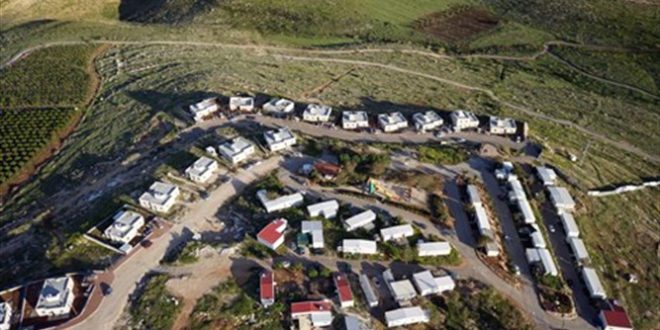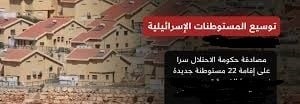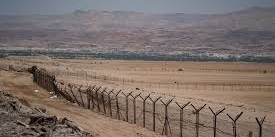By: Madeeha Araj,
The National Bureau for Defending the Land and Resisting Settlement stated that the Israeli Central Court’s resolution on keeping hundreds of settlement units in the occupied West Bank under an Israeli judicial procedure called “market regulations,” is a dangerous precedent that retroactively paves the way for the renewal of building settlements, and grants the settlers more incentives to steal more Palestinian lands without punishment.
The market regulations stipulated that any deal in the West Bank with or without the consent of the Civil Administration is valid, which means the settlement of the Jews in the West Bank is legal, and the compensation of the land owners is possible. Therefore, no need to evacuate the settlers and the decision is applied on hundreds of settlement units in the West Bank, so there will no longer be a need to evacuate those units. The Judge, Arnon Dral assured his acceptance of the settlers’ claims that they settled the land with the consent of the military governor and therefore do not have to evacuate.
The central court in Jerusalem’s decision came to settle settlement outposts of “Mitzpe Kramim” to reveal once again the reality of the political maneuvers that Netanyahu stands behind to gradually legitimize settlement outposts, recalling the deliberations conducted by the Israeli Supreme Court several years ago that revealed the truth of the leadership position which by all means intends to plunder Palestinian land. These deliberations have repeatedly confirmed that this is a settlers’ government.
Members of the Knesset and ministers of the Israeli government welcomed the decision of the Central Court in Jerusalem to settle the settlement outpost of Mitzpe Kramim under the claim that it was established “in good faith.” Not only the decision of the Central Court was welcomed, but asserted that the high court shall not deal with the Palestinian appeals as MK, Nissan Slomiansky of the Jewish House said that the Central Court is worthy of respect because it activated an item that prevented the high court from enforcing any decision.
For his part, Knesset Spokeperson, Yuli Edelstein said that “the determination of the settlers in Mitzpe Kramim has proven itself,” and welcomed the decision of the Central Court, considered it “just” and that it is required to be issued by the court. He also stressed the continuation of strengthening settlement. Moreover, the Central Court clearly stated that a person who is settled by a State permit and in good faith in his home will not be evicted, adding this is a blessed month for settlement, adding that the decision of the central court regarding the settlement of Mitzpe Kramim cames after the approval of the establishment of 3 new settlements.
Hebrew media also welcomed the decision, as the newspaper “Yediot Ahronot” Hebrew that the decision of the Israeli court to legitimize the settlement outpost, came under the pressure of the Israeli Minister of Justice, Ayelet Shaked, who praised the judicial decision. The decision of the court will be reflected on the fate of hundreds of settlement units built on private Palestinian land.
Recently, settlers have established an “illegal” settlement outpost near the settlement of Eli, on the land of the Qariot and Sawiya villages, south of Nablus. Five buildings were erected in the area. The Civil Administration stated that it didn’t have any idea on that. Head of the Settlement Council, Mati Binyamin said that he also does not know about the settlement.
A tent was also found in the area and a building likely to be used for housing. A commercial vehicle was seen, loaded with furniture. According to Palestinian sources, a group of settlers from the evacuated settlement of Amona set up 5 tents and foundations to construct sheep-tent on privately owned Palestinian land located between the settlements of Shilo and Eileh.
On the other hand, there is competition between party leaders and public opinion in Israel, which is more supportive of settlement activities, especially as the municipal elections in Jerusalem are drawing nearer. It has been revealed that the work will begin in early Sept. in a project to build hundreds of settlement units in the heart of the town of Beit Hanina, north of occupied Jerusalem. Mayor of the occupation in Jerusalem during a closed political conference said, 124 settlement units approved by the Planning Committee of the 324 is expected to be built in the heart of the Palestinian town, they claim that the lands on which the settlement will be built have been purchased 15 years ago by Jewish funds with the aim of creating a series of settlements in Jerusalem.
Israeli Education Minister, Naftali Bennett said that the momentum of settlement construction in West Bank settlements and occupied Jerusalem should continue. Added that in remarks broadcast by the official Israeli Broadcasting Corporation that “the discourse on the Israeli street has changed so that it is now focused on the application of Israeli sovereignty over the West Bank and Jerusalem instead of talking about the principle of a two-state solution . In a meeting with settler leaders in the West Bank on the eve of the Jewish New Year, he said that his party was working through the ruling coalition to expand settlements in the West Bank and raise the number of Jewish settlers to one million settlers during the coming years. Israeli War Minister, Avigdor Lieberman threatened to continue settlement construction in response to continued operations in the West Bank. “Israel will continue to build settlements, in the settlement of Adam, and everywhere.
In Ras Karkar village, west of Ramallah, head of the wall and settlement resistance committee, Walid Assaf, was injured by a rubber bullet in the ear during the course of his protest against the Israeli soldiers attempt to seize the Jabal al-Risan area west of the village. Israeli occupation forces fired rubber bullets at Assaf from a close point, wounding him in the left ear, two of his bodyguards in the hand and the back, as well as two other members of the demonstrators and an Israeli solidarity activist.
In Jerusalem, settlers confiscated accompanied by representatives of the “General Trustee – Custodian of Absentees’ Property” a private plot of land belonging to Abdul Razaq Sheikh near his house. The land is about 50 m2 in the western part of Sheikh Jarrah neighborhood, they bulldozed and uprooted fruitful trees, where the General Trustee – Custodian of Absentee Property ” claimed that the ownership of the land.
A list of Israeli Occupation and Settlers’ Assaults over the Last Week, Documented by the National Bureau:
Jerusalem:
- Demolishing a commercial facility i.e. a “Press” in Ein-Luza neighborhood in Silwan town, south of Al-Aqsa Mosque under the pretext of having no license.
- Arresting number of youths, assaulting children and injuring several women, including three pregnant women, as well as torturing a Jerusalem driver, Murad Samarin, who got injured of bruises and fractures in various parts of his body, and then was admitted to the hospital for treatment.
- Demolishing Container in Shu’fat neighborhood under the pretext of having no license, and demolishing a retaining wall in Um Tuba village, south of Jerusalem under the same pretext, and opening a new gate near the Damascus Gate leading to the Christian neighborhood.
Ramallah:
- Damaging 15 cars in Sinjel town, north of Ramallah. Writing racist slogans on the town walls saying: “The Jews will not be silent.”
- Injuring a number of Palestinian civilians arresting 4 others during dulldozing process on Ras Karkar village. Settlers brought bulldozers and equipment to open roads in Jabal Risan area, which is considered as a vital are full of olives trees.
Hebron:
- Bulldozing agricultural lands near the Apartheid Wall west of Beit-Ula, Hebron.
- Confiscating construction equipment from a house in Qawaqis area in Muasafer Yatta, owned by Jibril Mousa Abu ‘Aaram.
- Photographing of Yousef Ayoub Abu ‘Aram’s house, which is built of tin.
- Attacking a number of foreign solidarity activists near Mitzpe Yair outpost south of Hebron, they threw stones at them, broke their cameras and mobile phones, 4 activists were injured and taken to Israeli hospitals.
- Confiscating grapes, plums, tomatoes and other farmer products near Beit Ummar entrance, adjacent to the street no. 60.
- Stopping restoration process in the old town in the center of Hebron, and arrested the workers there under the pretext of a military order that prevents the work.
Bethlehem:
- Breaking into agricultural room in al-Khader town, south of Bethlehem and broke into an agricultural room built of iron on the land of Yassin Khader Issa and demolished it.
- Uprooting an iron gate on lands belonging to al-Khader town.
- Attacking the farmer Khader Ishaq Sobeih, expelled him from his land, and handing over orders to a number of land owners located near Al-Fridis Junction.
Nablus:
- Residents of Einabus village, south of Nablus, were attacked by a group of settlers from Yitzhar settlement, who attacked houses in the northern part of the village.
- Attacking Nihad Najeh Abdel Fattah’s house, located between the towns of Auref and ‘Einabus, and damaging the windows and glass of the house.
- Confrontations took place between young men and Israeli soldiers near Yosif Tomb, protected by soldiers.
Jenin:
- Attacking Palestinian vehicles near “Homesh settlement south of Jenin, causing damage to a number of civilian vehicles and traffic jam.
- Confiscating a bulldozer during raids near the Arab American University, east of Jenin.
- Demolishing a birds slaughterhouse with its equipment in Barta’a, southwest of Jenin, located inside the Wall of Annexation and Expansion, preventing its owner to empty the slaughterhouse.
- Demolishing two barracks, one under construction and the other for raising animals under the pretext of having no license.
Tulkarm:
- Bulldozing some of shufa town lands to expand Avni Hefetz The Israeli Occupation Authorities have handed over earlier farmers from the village of Shufa, southeast of Tulkarem orders to confiscate more of their land.
 المكتب الوطني للدفاع عن الارض ومقاومة الاستيطان منظمة التحرير الفلسطينية
المكتب الوطني للدفاع عن الارض ومقاومة الاستيطان منظمة التحرير الفلسطينية




